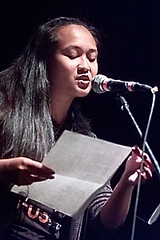One of the ironic coincidences of American history is that the oldest buildings still standing in
Fisherman’s Wharf is a curio for tourists, not fishermen, South of Market has been entirely gentrified, North of Market redefined again & again.
The history of
Barbara Jane Reyes’ Poeta en
The book is built symmetrically around three sections called [orient], [dis•orient] & [re•orient], in turn bracketed by relative brief pro- and epilogues. With [dis•orient] placed squarely at the center, Reyes moves through a cycle of poems, initially in verse form, a stanza of English followed by another of Tagalog, first in script, then phonetically. This in turn gives way to a series of prose poems, works in verse, even prayers:
[ave maria]
our lady who crushes serpents
our lady of lamentations
our lady full of grace whose weeping statues bleed,
our lady who makes the sun dance, pray for us
our lady of salt pilgrimage
our lady of building demolition
our lady of crack houses
santa maria, madre de dios, pray for us sinners
our lady of unbroken hymens
preteen vessel of god’s seed
your uterus is a blessed receptacle.
our lady of neon strip joints
our lady of blowjobs in kerouac alley
our lady of tricked out street kids, pray for us
blessed mother of cholo tattoos
you are the tightest homegirl
our lady of filas and lipliner
our lady of viernes santo procession
our lady of garbage-sifting toothless men
our lady of urban renewal’s blight
pray for us sinners ipanalangin n’yo kamin makasalanan
now and at the hour ngayon at kung
of our death kami ay mamamatay
amen
Although, seemingly the least postmodern poem in the book – the end of [dis•orient] returns obsessively to the form of prayer – “[ave maria]” conveys a lot of the tensions in the book very quickly, culturally, linguistically, politically. This poem comes immediately after one that visits the International Hotel site in San Francisco (just a couple of blocks down the street from Kerouac Alley), where, in the early 1970s, a building filled with Filipino men was plowed over in the name of development – last I saw, that development was yet to turn up. The opacity of Tagalog here is matched elsewhere in this book with a similar failure to understand English – what does “m-town” mean? Who was Charlie during the Vietnam War? – and will lead, in the [re•orient] section, to a fabulous piece called “[Filipino Names],” like Rocky, Hazel, Ichiban, Bong, Dodo & GE
Does not stand for General Electric.
But no one can tell us her real name.
Elsewhere there is an allusion to calle de sección ocho & I wondered how many readers – especially at a distance, physically or culturally – will get it that that is a reference to federally subsidized housing. There are moments here in which I deeply felt how cut off I am by my own monophone roots, but this book is set up I think to let nearly everyone have some sense of this. What it is for me might not be the passages it would be for someone else, but the presence is pretty much inescapable.
In the hands of a lesser talent, this direct confrontation with global politics could suffer from what I think of as “John Sayles disease,” obviousness, a poetry to be agreed with rather than experienced. It is precisely because Reyes doesn’t settle for simple, unconflicted answers – us good, them bad, modernity (and post-) even worse – but rather lets the conflicts stay conflicts, the tensions stay tense, that render this a compelling reading experience. You don’t need an m-town in your hometown for this to be a very important book.






